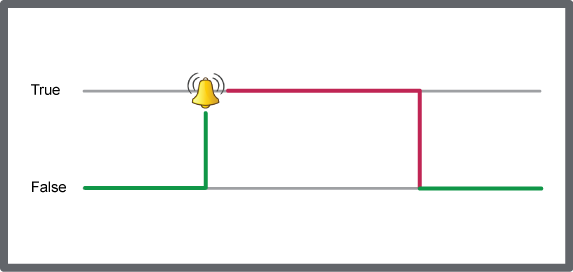
Como
Creating a Change of State Alarm
You create a change of state alarm to trigger an alarm when a variable, such as a switch, is either true or false.
In WorkStation, in the System Tree pane, select the folder or EcoStruxure BMS server where you want to create the alarm.
On the File menu, point to New and then click Alarm .
In the Create Object dialog box, in the object type list, select Change of State Alarm .
In the Name box, type a name for the alarm.
In the Description box, type a description for the alarm.
Click Next .
In the Alarm Trigger page, select the state of the monitored variable that triggers the alarm:
Click True to trigger the alarm when the monitored variable is equal to True .
Click False to trigger the alarm when the monitored variable is equal to False .
In the Monitored variable box, enter the variable that the alarm monitors.
In the Disable alarm box, select whether or not to create the alarm in disabled mode.
Under Time Delay and Shunt Variables , in the Alarm delay box, enter the time delay.
In the Reset delay box, enter the time delay.
Select Invert to have the alarm enabled when the first shunt variable is active.
In the Shunt variable 1 box, enter the binary variable that enables or disables the alarm.
In the Operator list, select AND or OR to add logic between the first shunt variable and the second shunt variable.
Select Invert to have the alarm enabled when the second shunt variable is active.
In the Shunt variable 2 box, enter the binary variable that enables or disables the alarm.
Click Next .
In the Presentation page, in the Alarm message box, type the message to display when the monitored variable exceeds the alarm limit.
In the Reset message box, type the message to display when the alarm is reset.
In the Category box, enter the category the alarm belongs to.
In the Category 2 box, enter the second category the alarm belongs to.
In the Prefix for alarm source name box, type a prefix that is added to the beginning of the source name property of an alarm record.
NotaYou can add alarm substitution codes to a prefix for the alarm source name. Para mais informações, consulte Alarms Substitution Codes .
In the Alarm priority box, enter the priority for the alarm state.
Select Same priority to let the Reset priority box inherit the value in the Alarm priority box.
In the Reset priority box, enter the priority for the reset state.
Select Auto hide to automatically hide the alarm in the Alarms pane or Alarm View.
Select Flashing alert to make the alarm flash in the Alarms pane and Alarm Views when it is triggered.
Select Audible alert to play a sound when the alarm is triggered.
In the Custom audio box, enter the path to the custom audio file you want to play when the alarm is triggered.
NotaIf you have selected Audible alert but not selected any custom audio file, the default alarm sound is played when the alarm is triggered.
Select Disable state-change logging to prevent an alarm state change from creating an event.
Click Next .
In the User Action page, select the type of acknowledgement to use:
Click No when the alarm does not need to be acknowledged.
Click Single when the alarm needs to be acknowledged in the alarm state.
Click Extended when the alarm needs to be acknowledged in the alarm state and the reset state.
In the Cause note group box, enter a cause note group that you want to connect to the alarm.
In the Action note group box, enter an action note group that you want to connect to the alarm.
In the Checklist box, enter a checklist that you want to connect to the alarm.
Select When acknowledging an alarm: Comment to force the user to add a comment to the alarm before the alarm can be acknowledged.
Select When acknowledging an alarm: Cause note to force the user to edit the connected cause note before the alarm can be acknowledged.
Select When acknowledging an alarm: Action note to force the user to edit the connected action note before the alarm can be acknowledged.
Select When acknowledging an alarm: Checklist to force the user to go through the connected checklist before the alarm can be acknowledged.
Under Required User Actions , select the actions for Comment , Cause note , and Action note to specify how the user should respond to the actions.
Click Next .
In the Attachment page, click the Add attachment button
to add an attachment.action_zoom_plus_stroke 
In the Select Object dialog box, select the object you want to attach to the alarm .
Click Select .
On the Attachment page, in the Display on alarm column, select the check box to automatically open the attachment when the alarm is triggered.
Click Create .
 Change of State Alarms
Change of State Alarms
 Create Change of State Alarm Wizard – Alarm Trigger Page
Create Change of State Alarm Wizard – Alarm Trigger Page
 Change of State Alarm Properties – Basic Tab
Change of State Alarm Properties – Basic Tab
 Create Alarm Wizard – User Action Page
Create Alarm Wizard – User Action Page
 Create Alarm Wizard – Presentation Page
Create Alarm Wizard – Presentation Page
 Create Alarm Wizard – Attachment Page
Create Alarm Wizard – Attachment Page
 Alarm States
Alarm States
 Custom Audible Alarm Alerts
Custom Audible Alarm Alerts
 Alarms Substitution Codes
Alarms Substitution Codes
 Alarm Categories
Alarm Categories

